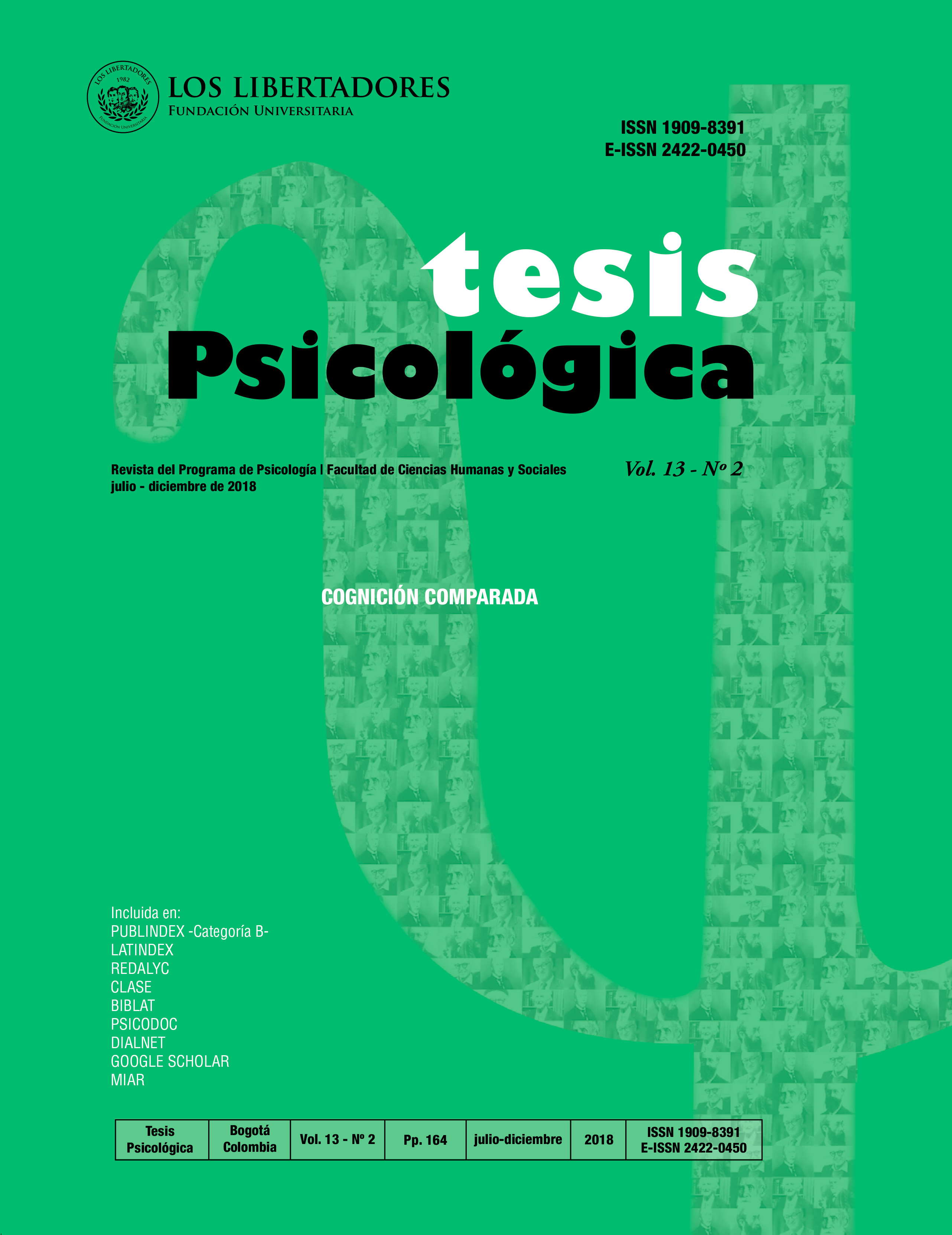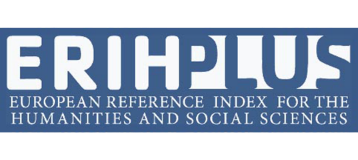Conditional discrimination of the spatial orientation of the own behavior in adult and young Wistar rats.
DOI:
https://doi.org/10.37511/tesis.v13n2a5Abstract
Conditional self-discrimination is the learned ability that animals have shown to discriminate aspects of the individual, such as their own behavior, their own internal states or their own image. This concept corresponds to the behavioral version of self-awareness. Some authors suggest that this process have a phylogenetic course and depends on the social structure of the species. However, we have not detected research on its ontogenetic course. This study aimed to explore experimentally the relationship between age and the acquisition of conditional self-discrimination. In particular, a matching-to-sample experimental paradigm of conditional discrimination of the spatial orientation of the own behavior in rats was developed in a symmetric Y-maze. This type of labyrinth allows controlling external keys of spatial orientation, in addition to allow sequences of trials followed without the intervention of the experimenter. A first pilot study was conducted with eight adult subjects of the Wistar strain (weeks 19 to 32 of age) and, subsequently, the experimental study was carried out with the four young subjects (weeks 7 to 23 of age). Comparison stimuli associated with spatial orientation of the own behavior ("previous turn to the left" vs. "previous turn to the right") were geometric figures (triangle vs. circle) of yellow color on a black background. Discrimination index required to demonstrate acquisition was 0.8 in at least one trial. In the pilot study, six of eight adult subjects achieved the required level, while, in the experimental group, three of four young subjects achieved the criterion. Although both groups showed a tendency to acquire conditional self-discrimination, the acquisition rhythms were different according to age, consistent with the inverted U hypothesis of the ontogeny of learning, that is: younger subjects learn more slowly than adult ones. However, to complete the test of such hypothesis, an additional study is required with older subjects. Our ontogenetic findings complement the comparative studies of animal self-awareness, which give clues of the phylogeny of this process.
Downloads
References
American Psychological Association (1992). Ethical Principles of Psychologists and Code of Conduct. American Psychologist 47(12), 1597-1611. DOI: 10.1037/0003-066X.47.12.1597
Baker, H. J., Lindsey, J. R. & Weisbroth S. H. (1979). Appendix 1: selected normative data. In: H. J. Baker, J. R. Lindsey. & S. H. Weisbroth. (Eds.), Biology and diseases. The laboratory rat: volume I (pp. 411). New York: Academic Press.
Beninger, R. J., Kendall, S. B. & Vanderwolf, C. H. (1974). The ability of rats to discriminate their own behaviours. Canadian Journal of Psychology, 28, 79-91.
Boakes, R. A. (1989). Historia de la psicología animal: de Darwin al conductismo. Madrid: Alianza Editorial.
Chalmers, D. J. (1996). The conscious mind: In search of a fundamental theory. New York: Oxford University Press.
Díaz, J. L. (2007). La conciencia viviente. México: Fondo de Cultura Económica.
Dymond, S. & Barnes, D. (1997). Behavior-analytic approaches to self-awareness. The Psychological Record, 47, 181-200.
Epstein, R., Lanza, R. P. & Skinner, B. F. (1981). “Self-awareness” in the pigeon. Science, 212(4495), 695-696.
3
Tesis Psicológica vol. 13- nº2 julio-diciembre/18 pp. 1-25 ISSN 1909-8391
Fabbro, F., Aglioti, S. M., Bergamasco, M., Clarici, A. & Panksepp, J. (2015). Evolutionary aspects of self- and world consciousness in vertebrates. Frontiers in Human Neuroscience, 9157. doi:10.3389/fnhum.2015.00157.
García, A. & Benjumea, S. (2006). The emergence of symmetry in a conditional discrimination task using different responses as propioceptive samples in pigeons. Journal of the Experimental Analysis of Behavior, 86(1), 65–80. doi.org/10.1901/jeab.2006.67-04
Hafting, T., Fyhn, M., Molden, S., Moser, M.B., & Moser, E.I. (2005). Microstructure of a spatial map in the entorhinal cortex. Nature, 436, 801-806.
Hermosillo, A. C., Penagos-Corzo, J. C. & Pérez-Acosta, A. M. (2011). Diferencias en la autodiscriminación condicional entre cepas Wistar y Sprague-Dawley. Interamerican Journal of Psychology, 45(3), 449-456.
Lewis, E. M., Barnett, J. F. Jr., Freshwater, L., Hoberman, A. M. & Christian, M. S. (2002). Sexual maturation data for Crl Sprague- Dawley rats: Criteria and confounding factors. Drug and Chemical Toxicology, 25(4), 437-458.
O’Keefe, J. & Nadel, L. (1978). The hippocampus as a cognitive map. Oxford: The Clarendon Press.
Otis, E. M. & Brent, R. (1954). Equivalent ages in mouse and human embryos. The Anatomical Record, 120(1), 33-63.
Penagos-Corzo, J. C. Hermosillo, C. & Pérez-Acosta A. M. (2011). Interacción social y autodiscriminación condicional bajo efectos de metilfenidato en ratas norvegicus. Revista Internacional de Psicología y Terapia Psicológica, 11(3), 443-454.
4
Tesis Psicológica vol. 13- nº2 julio-diciembre/18 pp. 1-25 ISSN 1909-8391
Penagos-Corzo, J.C., Pérez-Acosta, A. M. & Hernández, I. (2015). Interacción social y condicional auto-discriminación bajo un paradigma de evitación y el refuerzo positivo en ratas Wistar. Psicológica: Revista Internacional de Metodología y Psicología Experimental, 36(1), 1-15.
Pérez-Acosta, A. M. (2006). Autodiscriminación condiciónal, metaconducta y autoclítica: posibilidades investigativas. Psicología desde el Caribe, 17, 103-121.
Pérez-Acosta, A. M. (2007). La consciencia desde el análisis experimental del comportamiento: adquisición y transferencia de la autodiscriminación condicional. Recuperado de http://fondosdigitales.us.es/thesis/thesis_view?oid=759
Pérez-Acosta, A. M. & Benjumea, S. (2003). Adquisición y prueba de transferencia de la autodiscriminación condicional en palomas. Acta Colombiana de Psicología, 10, 45-71.
Pérez-Acosta, A. M., Benjumea, S. & Navarro, J. (2001). Autoconciencia animal: estudios sobre la autodiscriminación condicional en varias especies. Revista Latinoamericana de Psicología, 33(3), 311-327.
Pérez-Acosta, A. M., Benjumea, S., & Navarro, J. (2002). Autodiscriminación condicional: la autoconciencia desde un enfoque conductista. Revista Colombiana de Psicología, 11, 71-80.
Pérez-Acosta, A. M. & Rozo, J. A. (2018). Dos décadas de investigación experimental sobre autodiscriminación condicional en varias especies. En: Sociedad Interamericana de Psicología (compilador), Memorias del XXXVI Congreso Interamericano de Psicología, julio 2017. Mérida, Yucatán. Línea Temática I: Del pasado de la disciplina hacia nuevos
5
Tesis Psicológica vol. 13- nº2 julio-diciembre/18 pp. 1-25 ISSN 1909-8391
horizontes en la búsqueda de sociedades más justas (pp. 364-366). México: Universidad Autónoma Metropolitana. DOI: 10.13140/RG.2.2.21863.70568.
Red Colombiana de Comités Institucionales para el Cuidado y Uso de Animales (2011). Red CICUALES Colombia. Recuperado el 6 de mayo de 2019 de: http://www.redcicuales.org/
República de Colombia (2006). Ley 1090 (septiembre 6). Por la cual se reglamenta el ejercicio de la profesión de Psicología, se dicta el Código Deontológico y Bioético y otras disposiciones. Recuperado el 6 de mayo de 2019 de: http://colpsic.org.co/aym_image/files/LEY_1090_DE_2006.pdf
Rozo, J. A. (2017). Autoconciencia a través del ciclo vital. Autodiscriminación condicional en ratas Wistar. En: COLPSIC y ASCOFAPSI (Eds.), Memorias Congreso Colombiano de Psicología 2017: Psicología y Construcción de Paz (pp. 865-866). Bogotá: Colegio Colombiano de Psicólogos.
Sengupta, P. (2013). The laboratory rat: Relating its age with human’s. International Journal of Preventive Medicine, 4(6), 624–630.
Shimp, C. P. (1984). Self reports by rats of the temporal patterning of their behavior: a dissociation between tacit knowledge and knowledge. En H. L. Roitblat, T. G. Bever & H. S. Terrace (Eds.), Animal cognition (pp. 215-229). HiIIsdale, NJ: Erlbaum.
Tolman, E. C. (1948). Cognitive maps in rats and men. Psychological Review, 55(4), 189-208. doi.org/10.1037/h0061626
6
Tesis Psicológica vol. 13- nº2 julio-diciembre/18 pp. 1-25 ISSN 1909-8391
Wills, T. J., Muessig, L. & Cacucci, F. (2014). The development of spatial behaviour and the hippocampal neural representation of space. Philosophical Transaction of the Royal Society B: Biological Sciences, 369(1635), 1-13. doi: 10.1098/rstb.2013.0409
Additional Files
Published
Issue
Section
License

This work is licensed under a Licencia Creative Commons Atribución-NoComercial-













